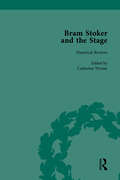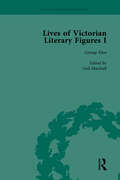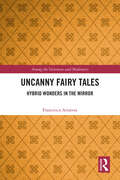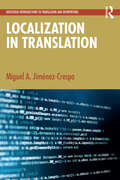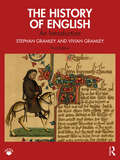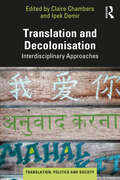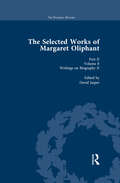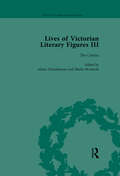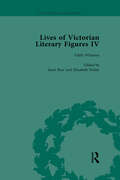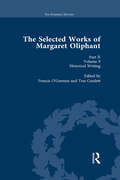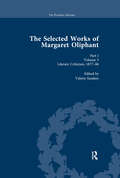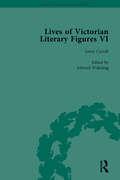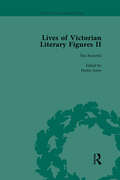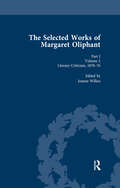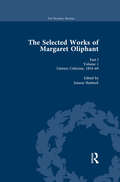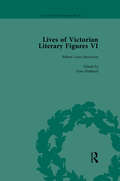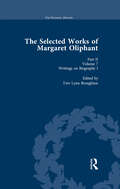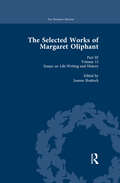- Table View
- List View
Bram Stoker and the Stage, Volume 1: Reviews, Reminiscences, Essays and Fiction
by Catherine WynneThough best known as the author of Dracula (1897) Bram Stoker had a successful career in the theatre. This collection brings together all Stoker's theatrical reviews from Dublin's Evening Mail, his published essays and interviews on the theatre, selections from Reminiscences of Henry Irving (1906) and a fictional work on the theatre.
Lives of Victorian Literary Figures, Part I, Volume 1: George Eliot, Charles Dickens and Alfred, Lord Tennyson by their Contemporaries
by Gail Marshall Ralph Pite Corinna RussellCollected here are the biographies which revealed aspects of their subjects that the more favourable "official" accounts tended to hide. The life of the author of each text is described, and their relation to the writers they portray is sketched in.
Bram Stoker and the Stage, Volume 1: Reviews, Reminiscences, Essays and Fiction
by Catherine WynneThough best known as the author of Dracula (1897) Bram Stoker had a successful career in the theatre. This collection brings together all Stoker's theatrical reviews from Dublin's Evening Mail, his published essays and interviews on the theatre, selections from Reminiscences of Henry Irving (1906) and a fictional work on the theatre.
Lives of Victorian Literary Figures, Part I, Volume 1: George Eliot, Charles Dickens and Alfred, Lord Tennyson by their Contemporaries
by Gail Marshall Ralph Pite Corinna RussellCollected here are the biographies which revealed aspects of their subjects that the more favourable "official" accounts tended to hide. The life of the author of each text is described, and their relation to the writers they portray is sketched in.
Uncanny Fairy Tales: Hybrid Wonders in the Mirror (Among the Victorians and Modernists)
by Francesca ArnavasThere are fairy tales that surprise, destabilise, or even shock us: these are uncanny fairy tales that manipulate familiar stories in creative and bewildering ways in order to express new meanings. This work analyses these tales, basing its approach on a reformulation of Freud’s concept of the uncanny. Through a cognitive outlook the employed theoretical framework provides new perspectives on the study of experimental literary fairy tales. Considering English-language literature, complex and unsettling reinterpretations of the fairy-tale discourse began to appear during the Victorian Age, later resurfacing as a postmodern trend. This research individuates uncanny-related narrative techniques and cognitive responses as means to decodify and explore these tales, and as ways to discover unseen connections between Victorian and postmodern texts. The new theorisation of the uncanny is linked with three subconcepts: mirror, hybridity, and wonder, which function as tools to describe and investigate the cognitive and emotional entanglements characterising enigmatic and disorienting fairy tales.
Uncanny Fairy Tales: Hybrid Wonders in the Mirror (Among the Victorians and Modernists)
by Francesca ArnavasThere are fairy tales that surprise, destabilise, or even shock us: these are uncanny fairy tales that manipulate familiar stories in creative and bewildering ways in order to express new meanings. This work analyses these tales, basing its approach on a reformulation of Freud’s concept of the uncanny. Through a cognitive outlook the employed theoretical framework provides new perspectives on the study of experimental literary fairy tales. Considering English-language literature, complex and unsettling reinterpretations of the fairy-tale discourse began to appear during the Victorian Age, later resurfacing as a postmodern trend. This research individuates uncanny-related narrative techniques and cognitive responses as means to decodify and explore these tales, and as ways to discover unseen connections between Victorian and postmodern texts. The new theorisation of the uncanny is linked with three subconcepts: mirror, hybridity, and wonder, which function as tools to describe and investigate the cognitive and emotional entanglements characterising enigmatic and disorienting fairy tales.
Localization in Translation (Routledge Introductions to Translation and Interpreting)
by Miguel A. Jiménez-CrespoLocalization is everywhere in our digital world, from apps to websites or games. Our interconnected digital world functions in part thanks to invisible localization processes that allow global users to engage with all sorts of digital content and products. This textbook presents a comprehensive overview of the main theoretical, practical, and methodological issues related to localization, the technological, textual, communicative, and cognitive process by which interactive digital texts are prepared to be used in contexts other than those of production.Localization in Translation provides an interdisciplinary introduction to the main practical and theoretical issues involved in localizing software, web, video games, and apps. It discusses the many technological, cultural, linguistic, quality, economic, accessibility, and user-reception issues related to the different localization types. It also provides an updated overview of localization in an ever-changing technological landscape marked by advances in neural machine translation and AI. Each chapter includes a basic summary, key questions, a final section with discussion and assignments, as well as additional readings. Online resources with additional questions and assignments are included on the Routledge Translation Studies portal.This is the essential textbook for advanced undergraduates and graduates in translation studies and translation professionals engaged in localization practice.
Localization in Translation (Routledge Introductions to Translation and Interpreting)
by Miguel A. Jiménez-CrespoLocalization is everywhere in our digital world, from apps to websites or games. Our interconnected digital world functions in part thanks to invisible localization processes that allow global users to engage with all sorts of digital content and products. This textbook presents a comprehensive overview of the main theoretical, practical, and methodological issues related to localization, the technological, textual, communicative, and cognitive process by which interactive digital texts are prepared to be used in contexts other than those of production.Localization in Translation provides an interdisciplinary introduction to the main practical and theoretical issues involved in localizing software, web, video games, and apps. It discusses the many technological, cultural, linguistic, quality, economic, accessibility, and user-reception issues related to the different localization types. It also provides an updated overview of localization in an ever-changing technological landscape marked by advances in neural machine translation and AI. Each chapter includes a basic summary, key questions, a final section with discussion and assignments, as well as additional readings. Online resources with additional questions and assignments are included on the Routledge Translation Studies portal.This is the essential textbook for advanced undergraduates and graduates in translation studies and translation professionals engaged in localization practice.
The History of English: An Introduction
by Stephan Gramley Vivian GramleyThe History of English: An Introduction provides a chronological analysis of the linguistic, social, and cultural development of the English language from before its establishment in Britain around the year 450 to the present. Each chapter represents a new stage in the evolution of the language, all illustrated with a rich and diverse selection of primary texts. The book also explores the wider global course of the language, including a historical review of English in its pidgin and creole varieties and as a native and/or second language in the Caribbean, Africa, Asia, and Australasia.The third edition, carefully revised and updated throughout, includes:● chapter introductions and conclusions to assist in orientation plus additional marginal references throughout;● the addition of 21 timelines often running from Old English to Present-Day English and focusing on a variety of features;● a new focus on the relevance of change for and in Present-Day English;● discussions on the role and image of women, the (in-)visibility of social classes, and regional variation in English;● material on bilingualism, code-switching, and borrowing, and on the effects of the social media on language use;● over 90 textual examples demonstrating linguistic change and over 100 figures, tables, and maps, including 31 colour images, to support and illuminate the text;● updated online support material including brief introductions to Old and to Middle English, further articles on linguistic, historical, and cultural phenomena which go beyond the scope of the book, additional sample texts, exercises, and audio clips.With study questions as well as recommendations for further reading and topics for further study, The History of English is essential reading for any student of the English language and will be of relevance to any course addressing the origins and development of the English language.
The History of English: An Introduction
by Stephan Gramley Vivian GramleyThe History of English: An Introduction provides a chronological analysis of the linguistic, social, and cultural development of the English language from before its establishment in Britain around the year 450 to the present. Each chapter represents a new stage in the evolution of the language, all illustrated with a rich and diverse selection of primary texts. The book also explores the wider global course of the language, including a historical review of English in its pidgin and creole varieties and as a native and/or second language in the Caribbean, Africa, Asia, and Australasia.The third edition, carefully revised and updated throughout, includes:● chapter introductions and conclusions to assist in orientation plus additional marginal references throughout;● the addition of 21 timelines often running from Old English to Present-Day English and focusing on a variety of features;● a new focus on the relevance of change for and in Present-Day English;● discussions on the role and image of women, the (in-)visibility of social classes, and regional variation in English;● material on bilingualism, code-switching, and borrowing, and on the effects of the social media on language use;● over 90 textual examples demonstrating linguistic change and over 100 figures, tables, and maps, including 31 colour images, to support and illuminate the text;● updated online support material including brief introductions to Old and to Middle English, further articles on linguistic, historical, and cultural phenomena which go beyond the scope of the book, additional sample texts, exercises, and audio clips.With study questions as well as recommendations for further reading and topics for further study, The History of English is essential reading for any student of the English language and will be of relevance to any course addressing the origins and development of the English language.
Translation and Decolonisation: Interdisciplinary Approaches (Translation, Politics and Society)
by Claire Chambers Ipek DemirTranslation and Decolonisation: Interdisciplinary Approaches offers compelling explorations of the pivotal role that translation plays in the complex and necessarily incomplete process of decolonisation. In a world where translation has historically been a tool of empire and colonisation, this collection shines the spotlight on the potential for translation to be a driving force in decolonial resistance. The book bridges the divide between translation studies and the decolonial turn in the social sciences and humanities, revealing the ways in which translation can challenge colonial imaginaries, institutions, and practice, and how translation opens up South-to-South conversations. It brings together scholars from diverse disciplines and fields, including sociology, literature, languages, migration, politics, anthropology, and more, offering interdisciplinary approaches and perspectives. By examining both the theoretical and practical aspects of this intersection, the chapters of this agenda-setting collection explore the impact of translation on decolonisation and highlight the need to decolonise translation studies itself. The book illuminates the transformative power of translation in transcending linguistic, cultural, and political boundaries.
The Selected Works of Margaret Oliphant, Part II Volume 8: Writings on Biography II
by David JasperMargaret Oliphant (1828-97) had a prolific literary career that spanned almost fifty years. She wrote some 98 novels, fifty or more short stories, twenty-five works of non-fiction, including biographies and historic guides to European cities, and more than three hundred periodical articles. This is the most ambitious critical edition of her work.
Lives of Victorian Literary Figures, Part III, Volume 2: Elizabeth Gaskell, the Carlyles and John Ruskin
by Ralph Pite Valerie Sanders Aileen Christianson Simon Grimble Sheila A McintoshThomas and Jane Welsh Carlyle moved from rural Scotland to London's Cheyne Walk. This title focuses on writers for whom 'the centre' was a pressing concern. Elizabeth Gaskell, like her contemporary Emily Bronte, was from the north of England, though based in Lancashire and Cheshire rather than Yorkshire. Her first novel, Mary Barton 1848) was set in the north and was unusually realistic in its depiction of Manchester working-class life. Ruskin grew up in suburban London; in later life, he settled in the Lake District . The three volumes that comprise a set are facsimile reproductions of contemporary biographical material. They include letters, memoirs, poems and articles on three outstanding Victorian literary persons: John Ruskin, Elzabeth Gaskell and the Carlyles.
Lives of Victorian Literary Figures, Part IV, Volume 3: Henry James, Edith Wharton and Oscar Wilde by their Contemporaries
by Janet Beer Elizabeth Nolan Ralph Pite Sarah Annes Jane SpiritPart of the "Lives of Victorian Literary Figures" series, this set collects contemporary memoirs, biographies and ephemera relating to Oscar Wilde, Henry James and Edith Wharton. Editorial apparatus includes a general introduction, headnotes, endnotes and a general index.
The Selected Works of Margaret Oliphant, Part II Volume 9: Historical Writing
by Tess Cosslett Francis O’GormanMargaret Oliphant (1828-97) had a prolific literary career that spanned almost fifty years. She wrote some 98 novels, fifty or more short stories, twenty-five works of non-fiction, including biographies and historic guides to European cities, and more than three hundred periodical articles. This is the most ambitious critical edition of her work.
The Selected Works of Margaret Oliphant, Part I Volume 3: Literary Criticism 1877-86
by Valerie SandersMargaret Oliphant (1828-97) had a prolific literary career that spanned almost fifty years. She wrote some 98 novels, fifty or more short stories, twenty-five works of non-fiction, including biographies and historic guides to European cities, and more than three hundred periodical articles. This is the most ambitious critical edition of her work.
Lives of Victorian Literary Figures, Part VI, Volume 1: Lewis Carroll, Robert Louis Stevenson and Algernon Charles Swinburne by their Contemporaries
by Ralph Pite Edward Wakeling Tom Hubbard Rikky RooksbyIn their own time, Lewis Carroll, Robert Louis Stevenson and Algernon Charles Swinburne were highly successful writers. Part of the "Lives of Victorian Literary Figures" series, this three-volume facsimile edition draws together a range of biographical sources relating to these three celebrated Victorian authors.
Lives of Victorian Literary Figures, Part II, Volume 3: The Rossettis
by Hester JonesThe three volumes that comprise this set are facsimile reproductions of contemporary biographical material. They include letters, memoirs, poems and articles on three outstanding Victorian literary partnerships. These are the Brownings, Brontes and the Rossettis.
The Selected Works of Margaret Oliphant, Part I Volume 2: Literary Criticism 1870-76
by Joanne WilkesMargaret Oliphant (1828-97) had a prolific literary career that spanned almost fifty years. She wrote some 98 novels, fifty or more short stories, twenty-five works of non-fiction, including biographies and historic guides to European cities, and more than three hundred periodical articles. This is the most ambitious critical edition of her work.
The Selected Works of Margaret Oliphant, Part I Volume 1: Literary Criticism 1854-69
by Joanne ShattockMargaret Oliphant (1828-97) had a prolific literary career that spanned almost fifty years. She wrote some 98 novels, fifty or more short stories, twenty-five works of non-fiction, including biographies and historic guides to European cities, and more than three hundred periodical articles. This is the most ambitious critical edition of her work.
Lives of Victorian Literary Figures, Part VI, Volume 2: Lewis Carroll, Robert Louis Stevenson and Algernon Charles Swinburne by their Contemporaries
by Ralph Pite Edward Wakeling Tom Hubbard Rikky RooksbyIn their own time, Lewis Carroll, Robert Louis Stevenson and Algernon Charles Swinburne were highly successful writers. Part of the "Lives of Victorian Literary Figures" series, this three-volume facsimile edition draws together a range of biographical sources relating to these three celebrated Victorian authors.
The Selected Works of Margaret Oliphant, Part I Volume 1: Literary Criticism 1854-69 (The\pickering Masters Ser.)
by Elisabeth Jay Joanne ShattockMargaret Oliphant (1828-97) had a prolific literary career that spanned almost fifty years. She wrote some 98 novels, fifty or more short stories, twenty-five works of non-fiction, including biographies and historic guides to European cities, and more than three hundred periodical articles. This is the most ambitious critical edition of her work.
The Selected Works of Margaret Oliphant, Part II Volume 7: Writings on Biography I
Margaret Oliphant (1828-97) had a prolific literary career that spanned almost fifty years. She wrote some 98 novels, fifty or more short stories, twenty-five works of non-fiction, including biographies and historic guides to European cities, and more than three hundred periodical articles. This is the most ambitious critical edition of her work.
The Selected Works of Margaret Oliphant, Part III Volume 13: Essays on Life-Writing and History
by Joanne ShattockMargaret Oliphant (1828-97) had a prolific literary career that spanned almost fifty years. She wrote some 98 novels, fifty or more short stories, twenty-five works of non-fiction, including biographies and historic guides to European cities, and more than three hundred periodical articles. This is the most ambitious critical edition of her work.
The Selected Works of Margaret Oliphant, Part II Volume 8: Writings on Biography II
Margaret Oliphant (1828-97) had a prolific literary career that spanned almost fifty years. She wrote some 98 novels, fifty or more short stories, twenty-five works of non-fiction, including biographies and historic guides to European cities, and more than three hundred periodical articles. This is the most ambitious critical edition of her work.
